Chapter 2. Quality of Health Care
Contents
Components of Health Care Quality
How This Chapter Is Organizated
Categorization of Effectiveness Measures by Health Care Need
Effectiveness
Cancer
Diabetes
End Stage Renal Disease (ESRD)
Heart Disease
HIV and AIDS
Mental Health and Substance Abuse
Respiratory Disease
Nursing Home, Home Health, and Hospice Care
Patient Safety
Timeliness
Patient Centeredness
Summary Tables
References
As better understanding of health and sickness has led to superior ways of preventing, diagnosing, and treating diseases, the health of most Americans has improved dramatically. However, ample evidence indicates that some Americans do not receive the full benefits of high quality care. Specifically, extensive disparities in health care related to race, ethnicity, and socioeconomic status have been demonstrated by a substantial body of public health, social science, and health services research and confirmed by previous releases of the National Healthcare Disparities Report.
Components of Health Care Quality
Quality health care means doing the right thing, at the right time, in the right way, for the right people—and having the best possible results.1 Quality health care is care that is:2
- Effective—Providing services based on scientific knowledge to all who could benefit and refraining from providing services to those not likely to benefit.
- Safe—Avoiding injuries to patients from the care that is intended to help them.
- Timely—Reducing waits and sometimes harmful delays for both those who receive and those who give care.
- Patient centered—Providing care that is respectful of and responsive to individual patient preferences, needs, and values and ensuring that patient values guide all clinical decisions.
- Equitable—Providing care that does not vary in quality because of personal characteristics such as gender, ethnicity, geographic location, and socioeconomic status.
- Efficient—Avoiding waste, including waste of equipment, supplies, ideas, and energy.
Health care quality is measured in several ways, including:
- Clinical performance measures of how well providers deliver specific services needed by specific patients, such as whether children get the immunizations that they need.
- Assessments by patients of how well providers meet health care needs from the patient's perspective, such as whether providers communicate clearly.
- Outcome measures—such as death rates from cancers preventable by screening—that may be affected by the quality of health care received.
Return to Contents
How This Chapter Is Organized
This chapter presents information about disparities in the quality of health care in America, with a presentation of a subset of core measures. The measures used here are the same as those used in the National Healthcare Quality Report (NHQR), and this chapter is constructed to mirror sections in the NHQR—effectiveness, patient safety, timeliness, and patient centeredness. Due to constraints on the length of this report, only a subset of the core measures is presented. Effectiveness of care is presented in Chapter 2 in eight clinical condition or care setting areas: cancer; diabetes; end stage renal disease (ESRD); heart disease; HIV and AIDS; mental health and substance abuse; respiratory diseases; and nursing home, home health, and hospice care. Maternal and child health is discussed in Chapter 4, Priority Populations.
As in previous NHDRs, this chapter's discussion of quality of care focuses on disparities in quality related to race, ethnicity, and socioeconomic status in the general U.S. population. Disparities in quality of care within specific priority populations are presented in Chapter 4. This chapter also presents analyses of changes over time by race, ethnicity, and socioeconomic status, as well as some stratified analyses.
Return to Contents
Categorization of Effectiveness Measures by Health Care Need
In the effectiveness section of this chapter, measures are organized into categories related to the patient's need for preventive care, treatment of acute illness, and chronic disease management. There is sizable overlap among these categories, and some measures may be considered to belong in more than one category. Outcome measures are particularly difficult to categorize when prevention, treatment, and management all play important roles. For the purposes of this report, however, measures are placed into categories that best fit the general descriptions below:
- Prevention—Caring for healthy people is an important component of health care. Educating people about healthy behaviors can help to postpone and avoid illness and disease. Additionally, detecting health problems at an early stage increases the chances of effectively treating them, often reducing suffering and expenditures.
- Treatment—Even when preventive care is ideally implemented, it cannot entirely avert the need for acute care. Delivering optimal treatments for acute illness can help reduce the consequences of illness and promote the best recovery possible.
- Management—Some diseases, such as diabetes and end stage renal disease, are chronic, which means they cannot simply be treated once; they must be managed across a lifetime. Management of chronic disease often involves lifestyle changes and regular contact with a provider to monitor the status of the disease. For patients, effective management of chronic disease can mean the difference between normal, healthy living and frequent medical problems.
Note that findings for women and children, which parallel those presented in the NHQR for maternal and child health, are presented in the sections on women and children in Chapter 4. Effectiveness measures presented in this section are organized within the categories of prevention, treatment, and management. For findings related to all core measures of effectiveness, go to Tables 2.1a and 2.1b.
| Section |
Measure |
| Prevention: |
| Cancer (breast) |
Screening for breast cancer |
| Heart disease |
Counseling about overweight* |
| Heart disease |
Counseling about exercise |
| HIV and AIDS |
HIV testing* |
| Respiratory diseases |
Pneumococcal vaccination |
| Maternal and child health (women) |
Screening for breast cancer |
| Maternal and child health (women) |
Prenatal care/maternal care |
| Maternal and child health (children) |
Vaccinations |
| Maternal and child health (children) |
Dental care |
| Maternal and child health (children) |
Counseling about overweight*/healthy eating |
| Treatment: |
| Heart disease |
Recommended hospital care for heart failure |
| Mental health and substance abuse |
Receipt of treatment for depression |
| Mental health and substance abuse |
Treatment for illicit drug use |
| Respiratory diseases |
Recommended hospital care for pneumonia |
| Nursing home, home health, and hospice care |
Improved walking or moving |
| Nursing home, home health, and hospice care |
Hospitalization of home care patients |
| Maternal and child health (women) |
Recommended hospital care for heart attack |
| Maternal and child health (children) |
Hospital admissions for gastroenteritis |
| Management: |
| Diabetes |
Receipt of recommended services for diabetes |
| Diabetes |
Hemoglobin, cholesterol, blood pressure control |
| End stage renal disease (ESRD) |
Adequacy of hemodialysis |
| End stage renal disease (ESRD) |
Registration for transplantation |
| HIV and AIDS |
New AIDS cases |
| HIV and AIDS |
PCP and MAC prophylaxis* |
| Nursing home, home health, and hospice care |
Use of physical restraints |
| Nursing home, home health, and hospice care |
Presence of pressure sores |
| Nursing home, home health, and hospice care |
Hospice care*,i |
| Maternal and child health (women) |
Receipt of recommended services for diabetes |
| Maternal and child health (women) |
New AIDS cases |
| Maternal and child health (children) |
Hospital admissions for asthma* |
* Supplemental measure
i Two supplemental measures of hospice care are from the National Hospice and Palliative Care Organization Family Evaluation of Hospice Care: hospice patients who did not receive the right amount of medicine for pain and hospice patients who did not receive end-of-life care consistent with their stated wishes.
Return to Contents
Effectiveness
Cancer
| Type of statistic |
Number |
| Number of deaths (2007 est.) |
559,6503 |
| Cause of death rank (2004) |
2nd4 |
| Number of living Americans who have been diagnosed with cancer (2004 est.) |
10,762,2145 |
| New cases of cancer (2007 est.) |
1,444,9203 |
| New cases of breast cancer in women (2007 est.) |
178,4803 |
| Total costii (2006) |
$206.3 billion6 |
| Direct costsiii (2006) |
$78.2 billion6 |
| Cost effectiveness of breast cancer screening |
$35,000-$165,0007 |
| Cost effectivenessiv of cervical cancer screening |
$14,000-$35,000/QALY7 |
Note: Statistics may vary from previous years due to revised and updated source statistics or addition of new data sources.
Prevention: Screening for Breast Cancer
Ensuring that all populations have access to appropriate cancer screening services is a core element of reducing cancer health disparities.8This year the NHDR focuses on breast cancer; findings for colorectal cancer are found in the 2006 NHDR. Screening mammography is an effective way to discover breast cancer before a patient has symptoms and to reduce new cases of late stage disease and mortality caused by this cancer.9
ii Total cost is composed of the cost of medical care itself (direct cost) and the economic costs of morbidity and mortality (indirect cost).
iii Direct costs are defined as "personal health care expenditures for hospital and nursing home care, drugs, home care, and physician and other professional services."6
iv Cost effectiveness is measured here by the average net cost of each quality-adjusted life year (QALY) that is saved by the provision of a particular health intervention. QALYs are a measure of survival adjusted for its value: 1 year in perfect health is equal to 1.0 QALY, while a year in poor health would be something less than 1.0. A lower cost per QALY saved indicates a greater degree of cost effectiveness. For example, the net cost for colorectal cancer screening ranges from $0 to $14,000 for each QALY saved.
Figure 2.1. Women age 40 and over who report they had a mammogram within the past 2 years, by race (top left), ethnicity (top right), and income (bottom left)
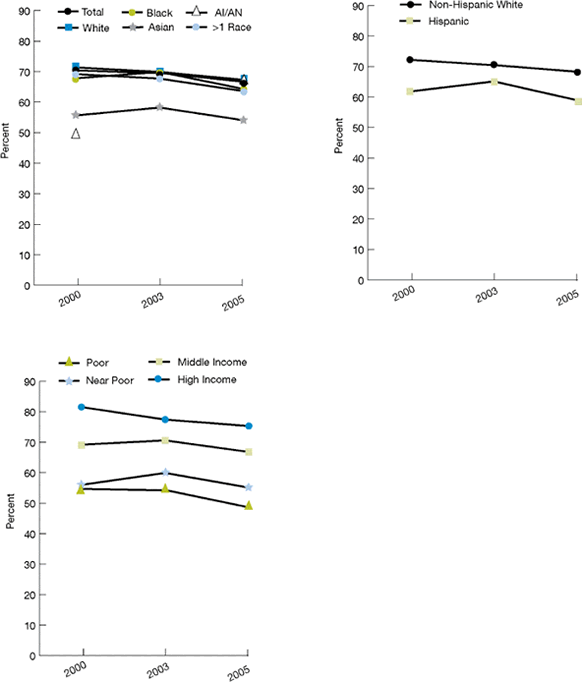
Source: Centers for Disease Control and Prevention, National Center for Health Statistics, National Health Interview Survey, 2000, 2003, 2005.
Reference population: Women age 40 and over in the civilian noninstitutionalized population.
Note: Data were insufficient for this analysis for American Indians and Alaska Natives (in 2003) and Native Hawaiians or Other Pacific Islanders (all data years).
- From 2000 to 2005, the proportion of women age 40 and over who had a mammogram within the past 2 years decreased significantly, 3.8% overall (from 70.4% to 66.6%; Figure 2.1).v
v The apparent decline in mammography rates between 2000 and 2005 based on the National Health Interview Survey (NHIS) is due at least in part to a change in the skip pattern for the 2005 NHIS mammography questions in order to obtain more accurate estimates. The Medical Expenditure Panel Survey (MEPS) indicates more stable rates of mammography over the period 2000 to 2005.
- During this period, the gap between Asians and Whites decreased. However, in 2005, mammography rates remained significantly lower for Asian women than for White women (54.0% compared with 67.3%).
- The gap between Hispanics and non-Hispanic Whites in the proportion of women age 40 and over who had a mammogram within the past 2 years decreased. However, in 2005, mammography rates remained significantly lower for Hispanic women than for non-Hispanic White women (58.9% compared with 68.2%).
- The gap between poor women and high income women remained the same. In 2005, the mammography rate for poor women was about two-thirds that for high income women (48.5% compared with 75.3%).
- In 2005, the only groups to achieve the Healthy People 2010 target of 70% of women age 40 and over receiving a mammogram within the past 2 years were women with high income (75.3%), women with at least some college education (72.5%, data not shown), and women with private insurance (74.2%, data not shown).
Racial and ethnic minorities are disproportionately of lower socioeconomic status. To distinguish the effects of race, ethnicity, income, and education on cancer screening, this measure is stratified by income (Figure 2.2) and education level (Figure 2.3).
Figure 2.2. Women age 40 and over who report they had a mammogram within the past 2 years, by race (left) and ethnicity (right) stratified by income, 2005
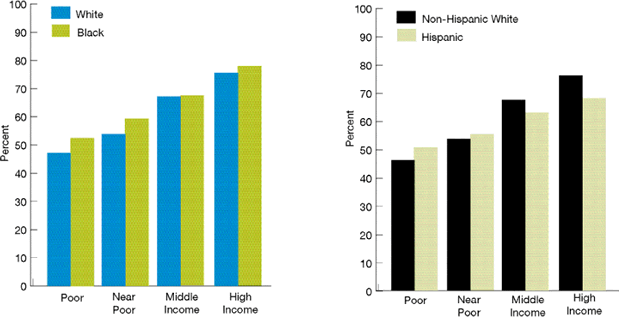
Source: Centers for Disease Control and Prevention, National Center for Health Statistics, National Health Interview Survey, 2005.
Reference population: Women age 40 and over in the civilian noninstitutionalized population.
Figure 2.3. Women age 40 and over who report they had a mammogram within the past 2 years, by race (left) and ethnicity (right) stratified by education, 2005
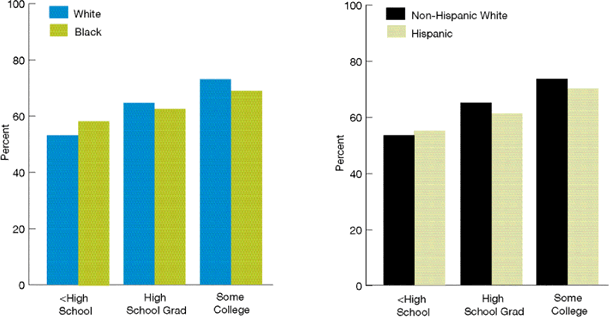
Source: Centers for Disease Control and Prevention, National Center for Health Statistics, National Health Interview Survey, 2005.
Reference population: Women age 40 and over in the civilian noninstitutionalized population.
- Both before and after controlling for income, there were no significant differences for Blacks compared with Whites or for Hispanics compared with non-Hispanic Whites in the rate of women age 40 and over who reported a mammogram in the past 2 years.
- After controlling for education, there were no significant differences for Blacks compared with Whites or for Hispanics compared with non-Hispanic Whites.
- Poor women were less likely than high income women to have had a mammogram within the past 2 years, regardless of race or ethnicity. Women with less than a high school education were less likely than women with some college to have had a mammogram, regardless of race or ethnicity.
Prevention: Advanced Stage Breast Cancer
Cancers can be diagnosed at different stages. The rate of cancers that are diagnosed at advanced stages is a measure of the effectiveness of cancer screening efforts. Differences in rates may vary across racial and ethnic groups due to differences in prevalence.
Figure 2.4. Age-adjusted rate of advanced stage (stage II or higher) breast cancer per 100,000 women age 40 and over, by race (left) and ethnicity (right), 1992-2004
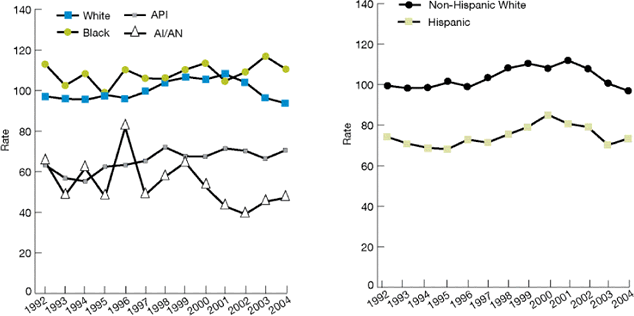
Key: AI/AN=American Indian or Alaska Native; API=Asian or Pacific Islander.
Source: National Cancer Institute, Surveillance, Epidemiology, and End Results program, 1992-2004.
Reference population: Women age 40 and over.
- From 1992 to 2004, the gaps between APIs and Whites and between AI/ANs and Whites in the proportion of advanced stage breast cancer have remained the same (Figure 2.4). In 2004, the proportion of advanced stage breast cancer was lower for APIs and AI/ANs than for Whites (70.5 per 100,000 for APIs and 47.1 per 100,000 for AI/ANs versus 93.7 per 100,000 for Whites).
- The proportion of advanced stage breast cancer was lower for Hispanics than for non-Hispanic Whites in all data years from 1992 to 2004, and the gap between Hispanics and non-Hispanic Whites has remained the same. During this period, the proportion for non-Hispanic Whites decreased from 99.4 to 96.9 per 100,000 while the proportion for Hispanics decreased from 74.1 to 73.3 per 100,000.
Return to Contents
Diabetes
| Type of statistic |
Number |
| Number of deaths (2004) |
72,8154 |
| Cause of death rank (2004) |
6th4 |
| Total number of Americans with diabetes (2005) |
20,800,00010 |
| Number of people with diagnosed diabetes |
14,600,00010 |
| Number of people with undiagnosed diabetes |
6,200,00010 |
| New cases (age 20 and over 2005) |
1,500,00010 |
| Total cost (2002) |
$132 billion11 |
| Direct medical costs (2002) |
$92 billion11 |
Note: Statistics may vary from previous years due to revised and updated source statistics or addition of new data sources.
Management: Receipt of Three Recommended Diabetes Services
Effective management of diabetes includes HbA1cvi testing, eye examination, and foot examination in the past year, as well as appropriate influenza immunization and lipid management.12, 13, 14
Figure 2.5. Adults age 40 and over with diabetes who had three recommended services for diabetes in the past year, by race, ethnicity, family income, and education, 2002-2004
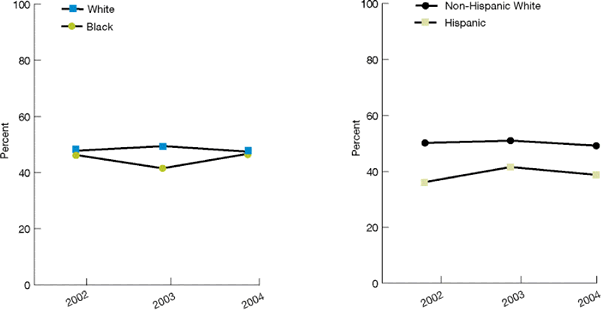
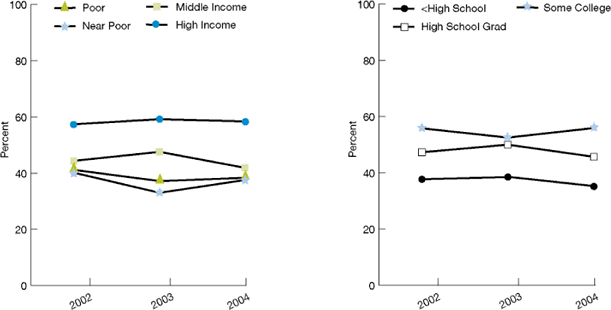
Source: Agency for Healthcare Research and Quality, Medical Expenditure Panel Survey, 2002-2004.
Reference population: Civilian noninstitutionalized population age 40 and over.
Note: Recommended services for diabetes are: (1) HbA1c testing, (2) retinal eye examination, and (3) foot examination in past year. Data include persons with both type 1 and type 2 diabetes. Rate is age adjusted to the 2000 standard population. Data were insufficient for this analysis for Native Hawaiians or Other Pacific Islanders and American Indians and Alaska Natives.
vi HbA1c is glycosylated hemoglobin and its level provides information about control of blood sugar levels.
- From 2002 to 2004, there were no significant changes for Blacks and Whites in the proportion of adults age 40 and over with diabetes who received three recommended services (Figure 2.5). In 2004, there also were no significant differences between Blacks and Whites for this measure (46.7% compared with 47.4%).
- The gap between Hispanics and non-Hispanic Whites in the proportion of adults age 40 and over with diabetes who received three recommended services remained the same. In 2004, this proportion was significantly lower for Hispanics than for non-Hispanic Whites (38.8% compared with 49.2%).
- From 2002 to 2004, the gap between poor people and high income people remained the same. In 2004, this proportion was significantly lower for poor (38.4%), near poor (37.6%), and middle income people (41.9%) than for high income people (58.4%).
- The gap between people with less than a high school education and people with at least some college education remained the same. In 2004, the proportion of adults age 40 and over with diabetes who received three recommended services was lower for people with less than a high school education and high school graduates than for people with at least some college (35.2% and 45.7% compared with 55.9%).
Prevention: Lower Extremity Amputations
Although diabetes is the leading cause of lower extremity amputations, amputations can be avoided through proper care on the part of patients and providers. Hospital admissions for lower extremity amputations for patients with diagnosed diabetes reflect poorly controlled diabetes. Better management of diabetes would prevent the need for lower extremity amputations. Differences in rates may also vary across racial and ethnic groups due to differences in prevalence.
Figure 2.6. Lower extremity amputations among patients with diabetes per 100,000 adult patients age 18 and over, by race ethnicity (left), and income (right), 2004
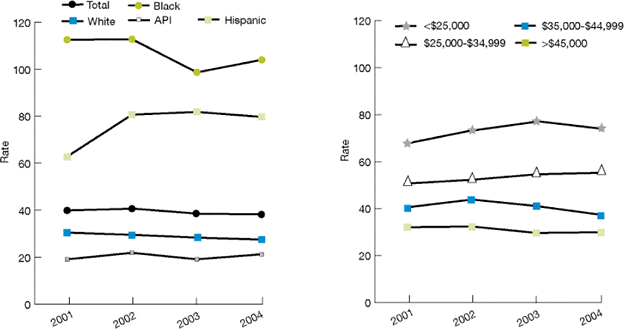
Key: API=Asian or Pacific Islander.
Source: Agency for Healthcare Research and Quality, Healthcare Cost and Utilization Project (HCUP) State Inpatient Databases (SID) disparities analysis file, 2001-2004.
Note: White, Black, and API are non-Hispanic groups. The HCUP SID disparities analysis file is designed to provide national estimates using weighted records from a sample of hospitals from 23 States that have 64% of the U.S. resident population. Income categories are based on the median income of the ZIP Code of the patients' residence.
- From 2001 to 2004, the gap between Blacks and Whites in the rate of lower extremity amputations in adults with diagnosed diabetes decreased (Figure 2.6). However, in 2004, the rate remained over three times higher for Blacks than Whites (104.0 per 1,000 compared with 27.6 per 1,000).
- The gap between Hispanics and Whites in the rate of lower extremity amputations in adults with diagnosed diabetes increased. In 2004, the rate was almost three times higher for Hispanics than Whites (79.7 per 1,000 compared with 27.6 per 1,000).
- From 2001 to 2004, the gap between APIs and Whites in the rate of lower extremity amputations in adults with diagnosed diabetes decreased. In 2004, the rate was lower for APIs than Whites (21.3 per 1,000 compared with 27.6 per 1,000).
- The gap in amputations between people with under $25,000 median household income and people with median household income over $45,000 did not change. In 2004, the rate was significantly higher for people living in communities with median household income under $25,000 (73.9 per 1,000), income $25,000-$34,999 (55.3 per 1,000), and median income $35,000-$44,999 (37.3 per 1,000) compared with people with median household income over $45,000 (29.9 per 1,000).
Management: Controlled Hemoglobin, Cholesterol, and Blood Pressure
People with diagnosed diabetes often have other cardiovascular risk factors such as high blood pressure and high cholesterol. The combination of these conditions with diabetes increases the likelihood of complications from diabetes, such as heart disease and stroke. Therefore, in addition to controlling blood sugar levels, diabetes management often includes treating high blood pressure and high cholesterol. HbA1c testing determines the average blood sugar level over 2-3 months and provides information about control of blood sugar levels. Checking blood pressure and cholesterol levels is also needed to assess control of these risk factors.vii
vii Blood pressure control guidelines were updated in 2005. Previously, having a blood pressure reading of <140/90 mm Hg was considered under control. For this measure, the new threshold of <140/80 mm Hg has been applied to historical data for the sake of consistency and comparability.
Figure 2.7. Adults age 40 and over with diagnosed diabetes with HbA1c (top left), total cholesterol (top right), and blood pressure (bottom left) under control, by race/ethnicity and income, 1988-1994 and 1999-2004
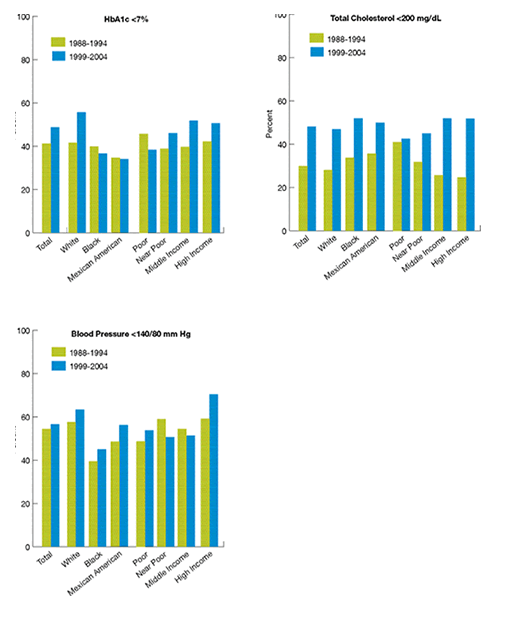
Source: Centers for Disease Control and Prevention, National Center for Health Statistics, National Health and Nutrition Examination Survey (NHANES), 1988-1994 and 1999-2004.
Reference population: Civilian noninstitutionalized population with diagnosed diabetes age 40 and over.
Note: Whites and Blacks are non-Hispanic groups; "Mexican American" is used in place of "Hispanic" because the NHANES is designed to provide estimates for this group rather than all Hispanics. Age adjusted to the 2000 U.S. standard population. Data were insufficient for this analysis for Native Hawaiians or Other Pacific Islanders and for American Indians and Alaska Natives.
HbA1c under control:
- From the 1988-1994 to 1999-2004 time periods, the percent of adults with diagnosed diabetes who had their HbA1c under optimal control did not change significantly (Figure 2.7). In 1999-2004, only 48.7% of adults with diagnosed diabetes had their HbA1c under optimal control.
- The gap between Blacks and Whites increased. In 1999-2004, the rate was significantly lower for Blacks than Whites (36.6% compared with 55.7%). There were no statistical differences between income groups for this measure.
- The gap between Mexican Americans and Whites increased. In 1999-2004, the rate was significantly lower for Mexican Americans than Whites (33.9% compared with 55.7%).
Total cholesterol under control:
- From the 1988-1994 to 1999-2004 time periods, the percent of adults with diagnosed diabetes who had their total cholesterol under control increased significantly. However, in 1999-2004, only 48.2% of adults with diagnosed diabetes had their total cholesterol under control.
- The gap between Blacks and Whites remained the same, and in 1999-2004, there were no statistically significant differences between racial groups.
- The gap between poor and high income persons was eliminated due to significant improvement in high income people (from 42.4% to 51.8%).
Blood pressure under control:
- From the 1988-1994 to 1999-2004 time periods, the percent of adults with diagnosed diabetes who had their blood pressure under control did not change. In 1999-2004, only 56.6% of adults with diagnosed diabetes had their blood pressure under control.
- The gap between Blacks and Whites remained the same. In 1999-2004, the rate was significantly lower for Blacks than Whites (45.0% compared with 63.4%). There was no statistical difference between Mexican Americans and Whites for this measure.
- The gap between poor people and high income people remained the same. In 1999-2004, the rate was significantly lower for poor (53.6%), near poor (50.7%), and middle income (51.3%) than high income people (70.4%).
End Stage Renal Disease (ESRD)
| Type of statistic |
Number |
| Total ESRD deaths (2004) |
84,25215 |
| Total cases (2004) |
472,09915 |
| New cases (2004) |
104,36415 |
| Total Medicare program expenditure for ESRD (2004) |
$18.4 million15 |
Note: Statistics may vary from previous years due to revised and updated source statistics or addition of new data sources.
Management: Patients With Adequate Hemodialysis
Dialysis removes harmful waste and excess fluid buildup in the blood that occurs when kidneys fail to function. Hemodialysis is the most common method used to treat advanced and permanent kidney failure. The adequacy of dialysis is measured by the percentage of hemodialysis patients with a urea reduction ratio (URR) equal to or greater than 65%; this measure indicates how well urea, a waste product, is eliminated by the dialysis machine.
Figure 2.8. Hemodialysis patients age 18 and over with adequate dialysis (urea reduction ratio 65% or higher), by race (left) and ethnicity (right), 2001-2005
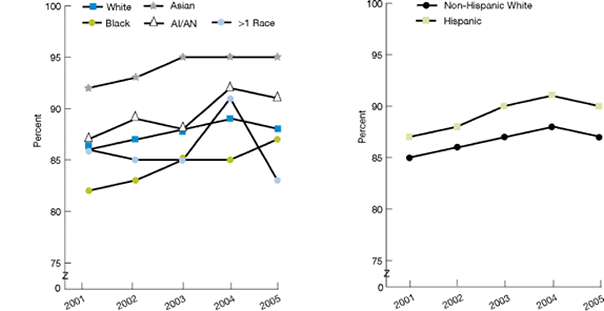
Key: AI/AN=American Indian or Alaska Native.
Source: Centers for Medicare & Medicaid Services, End Stage Renal Disease (ESRD) Clinical Performance Measures Project, 2001-2005.
Reference population: ESRD hemodialysis patients age 18 and over.
Note: Data were not available for Native Hawaiians or Other Pacific Islanders.
- From 2001 to 2005, the gap between Blacks and Whites in hemodialysis patients with adequate dialysis decreased, and it was eliminated in 2005 (87% compared with 88%; Figure 2.8).
- From 2001 to 2005, the gap between Asians and Whites remained the same. In 2005, the proportion with adequate dialysis was higher for Asians than for Whites (95% compared with 88%).
- The proportion with adequate dialysis improved for Hispanics (from 87% to 91%) and for non-Hispanic Whites (from 85% to 87%).
Management: Registration for Transplantation
Kidney transplantation often allows persons with ESRD to continue a lifestyle similar to that which they had before their kidney failure.16 It is important that persons with ESRD be registered on the waiting list for kidney transplantation to increase the likelihood of transplantation. However, there are many more people on the waiting list than people who receive transplantation; thus, being on the waiting list does not ensure one will receive a transplant.17 In 2004, there were 60,393 patients on the Organ Procurement and Transplantation Network (OPTN) donor kidney transplant waiting list in the United States, but only 10,228 donor kidney transplants were performed.15
Figure 2.9. Dialysis patients under age 70 registered on the waiting list for transplantation, by race (left) and ethnicity (right), 1998-2003

Key: AI/AN=American Indian or Alaska Native.
Source: U.S. Renal Data System, 1998-2003.
Reference population: End Stage Renal Disease hemodialysis patients and peritoneal dialysis patients under age 70.
Note: Data were not available for Native Hawaiians or Other Pacific Islanders.
- From 1998 to 2003, the gap between Blacks and Whites in the proportion of dialysis patients registered for transplantation remained the same. In 2003, Blacks were less likely to be registered for transplantation than Whites (10.5% compared with 16.1%; Figure 2.9).
- The gap between AI/ANs and Whites increased. In 2003, AI/ANs were less likely to be registered for transplantation than Whites (9.6% compared with 16.9%).
- The gap between Asians and Whites registered for transplantation increased. In 2003, this proportion was higher for Asians than for Whites (27.9% compared with 16.9%).
- The gap between Hispanics and non-Hispanic Whites in the proportion registered for transplantation decreased. However, in 2003, this proportion was lower for Hispanics than for non-Hispanic Whites (14.4% compared with 17.5%).
- From 1998 to 2003, none of the groups achieved the Healthy People 2010 target of 66%.

